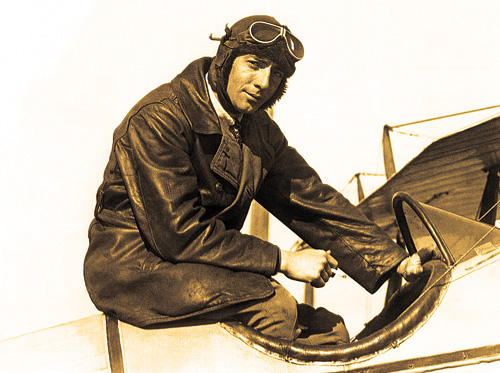INDIAN ARMED FORCES CHIEFS ON
OUR RELENTLESS AND FOCUSED PUBLISHING EFFORTS

SP Guide Publications puts forth a well compiled articulation of issues, pursuits and accomplishments of the Indian Army, over the years

I am confident that SP Guide Publications would continue to inform, inspire and influence.

My compliments to SP Guide Publications for informative and credible reportage on contemporary aerospace issues over the past six decades.
B.H. DeLay (1891-1923)
The list of “Daredevil” DeLay’s feats during his ten years of flying experience is endless. Many of them are commonplace nowadays but then they were aviation firsts. He remained constantly in the limelight.

Sooner or later death and destruction will intrude into any human endeavour. The 120-year history of aviation has seen numerous murders and murder-suicides. Violent hijackings or bombs planted in passenger aircraft were frequent in the second half of the 20th century, causing the deaths of hundreds of innocent people. This forced a tightening of airport screening and safety procedures. Hence both hijackings and aerial bombings have thankfully become rare. Several commercial flights have also been deliberately crashed (the 9/11 disasters being the most notorious) and others are suspected of having been so lost.
On a far smaller scale is the murder of a passenger or pilot while flying, either by someone on board, or due to the plane being tampered with before flight. Here is the story of the first case of suspected aerial murder in United States and perhaps world history. The victim was the American aviator, B.H. DeLay, who pioneered many of the popular stunts used in the early barnstorming air-shows. He also adapted them for movies involving many top Hollywood stars. Through his daring and innovative performances he greatly expanded the limits of the film industry in the US.
Beverly Homer DeLay was born on August 12, 1891. Not much is known of his childhood. But as a young adult he first gained fame as a race-car driver. Later he became a fervent aviation enthusiast. His air-show demonstrations included the nose dive, ghost dive, Immelmann turn, barrel rolls, tail spins, multiple loops, mock battles, racing, and flying fireworks. He helped set up America’s first aerial police force whose aircraft equipped with flotation devices could undertake maritime search and rescue at a moment’s notice. DeLay Airfield located in Venice – a Los Angeles beach resort – was the first lighted airport in the US.
The list of “Daredevil” DeLay’s feats during his ten years of flying experience is endless. Many of them are commonplace nowadays but then they were aviation firsts. He remained constantly in the limelight. He conducted aerial rides with politicians, actors and unusual personalities. He dropped event tickets, flew civil engineers to produce aerial maps of Venice, and showered other promotional or ceremonial objects for events, such as masses of flowers over the ocean as tributes to war heroes. It was American razzmatazz at its best. DeLay was seen in numerous motion pictures, including westerns, comedies and dramas. Many of his planes took part in movie aviator Ormer Locklear’s aerial funeral procession. Then there was the staple of Bollywood movies – the hero’s aerial transfer from plane to train or train to plane. He was also the first to knock down a building using a plane on screen.
In one of DeLay’s most spectacular events, aimed at promoting Venice Beach as a leading entertainment destination, he flew multiple loops at night. The plane had fireworks strapped to its back, so the show was billed as a “fire ride”. Simultaneously, 20 US Navy destroyer ships flashed their search lights on the horizon to accompany the performance. DeLay was also a humanitarian who frequently organised and performed in aviation benefit shows for individuals and organisations in need. In 1920, DeLay took over as general manager of the airport in Venice. By mid-1921, much of his earnings came from providing planes and pilots to Hollywood. And then his troubles began.
In September 1921, DeLay filed for a temporary restraining order against seven men, among them someone named C.E. Frey. Frey had begun claiming that DeLay’s lease of the airport had expired. He said, although he had no proof, that he was now the rightful operator and he was legally entitled to take over the airfield. It didn’t end there. DeLay was shot at by an unknown assailant, and Frey’s thugs planted posts in the runway do disrupt operations. When the posts were removed, the gang dug trenches so that the planes could not take off.
On July 4, 1923, DeLay was in his aircraft, the “Wasp” (along with passenger R.I. Short, President of the Essandee Corporation). While performing in front of thousands of people at Ocean Park, the plane’s wings began to quiver in the middle of a loop, and then suddenly folded back. The aircraft dove into the ground and burst into flames shortly after the two bodies were extricated from the wreckage.
B.H. DeLay’s friends went immediately to the police to complain of suspected foul play. They said that DeLay’s hangar was well-known and unguarded, making his planes easy to meddle with. An investigation found that the pins in the wings were of a substandard size of only 3/8 of an inch, rather than 1/2 or 3/4 inch, strongly pointing to wing tampering. However, the fire destroyed whatever other evidence there may have been. And so the case remained unsolved. A year later, DeLay’s ashes were buried at sea.





